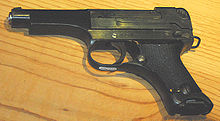Type 94 pistol
| Type 94 Nambu pistol | |
|---|---|

|
|
| general information | |
| Military designation: | Type 94 Nambu pistol |
| Country of operation: | Japan |
| Developer / Manufacturer: | Kijiro Nambu, Nagoya Arsenal |
| Manufacturer country: | Japan |
| Production time: | 1934 to 1945 |
| Weapon Category: | gun |
| Furnishing | |
| Overall length: | 180 mm |
| Total height: | 116 mm |
| Weight: (unloaded) | 0.72 kg |
| Barrel length : | 95 mm |
| Technical specifications | |
| Caliber : | 8 × 22 mm Nambu |
| Possible magazine fillings : | 6 cartridges |
| Ammunition supply : | Bar magazine |
| Number of trains : | 6th |
| Twist : | right |
| Charging principle: | Recoil loader |
| Lists on the subject | |
The Type 94 pistol , and Type 94 Nambu pistol ( Jap. 九四式拳銃 , Kjūjon-Shiki Kenju ), was a handgun , which during the Second World War to equip the armed forces of the Japanese Empire was one.
designation
The model designation did not refer to the year of the throne of the emperor who was in office when the weapon was introduced, as was often the case with Japanese weapons. In the case of this pistol, the information referred to the year since the founding of the Empire around 660 BC, according to that calendar, the introduction fell to the year 2594 (according to the western calendar 1934).
History and technology
Originally, the model was not intended for military use, but as a light and inexpensive compact weapon for the civilian export market. The designer Kijiro Nambu also wanted to fix some deficiencies in the Type 14 pistol , which he had also designed. The weak firing pin springs were replaced by stronger ones. Nambu's hopes for foreign business, however, were not fulfilled; only a small batch was exported to Thailand. Nor did the new pistol do any better than the older model; rather the opposite was the case. When the civilian 94 model was issued to the troops with the shortage of handguns, some shortcomings emerged:
- the already weak ammunition lost even more power due to the short barrel
- empty magazines were jammed by the breech and were difficult to remove
- dismantling was tedious
The most serious design flaw concerned the release mechanism. The sear was open on the left side and protruded a little when cocked. If this was now pushed back and there was a cartridge in the chamber , a shot was released (without touching the trigger). When soldiers fell, injuries occurred, and the weapon was also a danger for the wearer. In the course of the war, the manufacturing standards also deteriorated, so that specimens produced towards the end of the war were almost unusable as defensive weapons.
literature
- Military Intelligence Division, War Department (USA), Japanese infantry weapons, Special Series, no. 19 , 1943, "MODEL 94 (1934) 8-MM PISTOL" on pages 21 to 25, ISBN 978-0-8071-2013- 2 ( available online ).
- David Miller: Fighting Men of World War II, Axis Forces . Uniforms, Equipment & Weapons of Axis Forces. 1st edition. Stackpole Books, 2007, ISBN 978-0-8117-0277-5 , Japan, pp. 227 .
